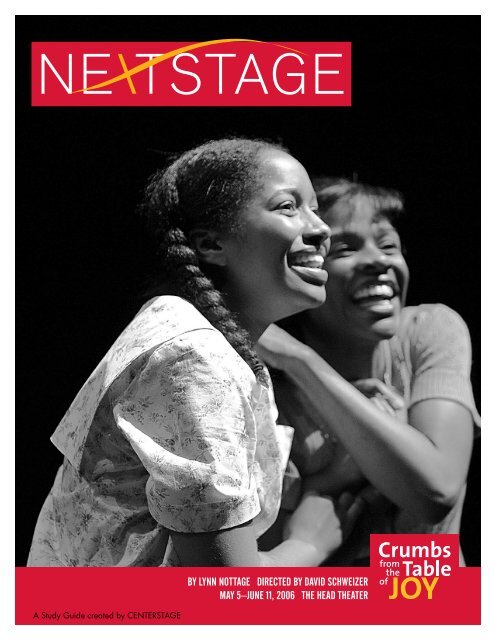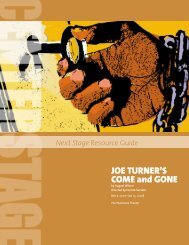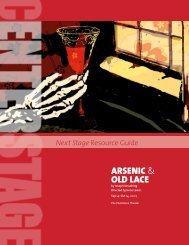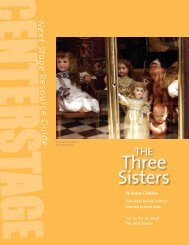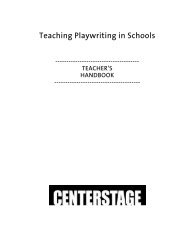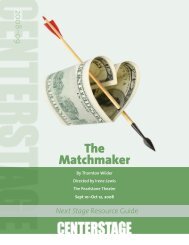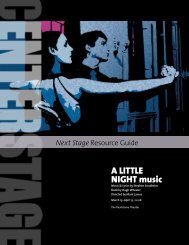You also want an ePaper? Increase the reach of your titles
YUMPU automatically turns print PDFs into web optimized ePapers that Google loves.
ne\TstageA Study Guide created by CENTERSTAGEby Lynn Nottage Directed by David SchweizerMay 5–June 11, 2006 The Head TheaterNEXTSTAGE | Crumbs from the Table of Joy
The Artistic TeamDirectorDavid SchweizerScenic DesignerJames NooneCostume DesignerDavid BurdickLighting DesignerAlexander NicholsSound DesignerMark BennettSpeech ConsultantGillian Lane-PlesciaChoreographerMichael J. BobbittProduction DramaturgLiana ThompsonCasting DirectorJudy DennisAssistant DirectorAdrian WattenmakerThe castGerte CrumpPatricia Ageheim*Ermina CrumpEdwina Findley*Godfrey CrumpLeLand Gantt*Ernestine CrumpAmina S. Robinson*Lily Ann GreenKelly Taffe*<strong>Stage</strong> ManagerMike Schleifer*Assistant <strong>Stage</strong> ManagerLauren Wright*settingBrooklyn, 1950Running time is approximately2 hours, including one15-minute intermission.*Member of Actors’ Equity Association,the Union of Professional Actors and<strong>Stage</strong> Managers in the United Statesne\TstageCrumbs from the Table of Joy May 5–June 11, 2006700 North Calvert StreetBaltimore, MD 21202Artistic Director Irene LewisManaging Director Michael RossArt Director Bill GeenenGraphic Designers Dina Epshteyn,Jason GembickiEditors Aaron Heinsman, SteveLichtensteinContributors Steve Lichtenstein,Otis Ramsey-Zöe, Liana ThompsonCorporate Support The Black &Decker Corporation, CitiFinancial andCitigroup Foundation, DLA PiperRudnick Gray Cary US LLP, Legg Mason,Inc., M&T Bank, Procter & GambleCosmetics Foundation, Provident Bank,T. Rowe Price Associates Foundation,Inc., Target Stores, Verizon, Wal-Mart,Washington GasFoundation & INDIVIDUAL SupportAnonymous, The Helen P. DenitCharitable Trust, The Family Leagueof Baltimore City, Inc., The GoldsmithFamily Foundation, Lockart VaughanFoundation, The Macht PhilanthropicFund, The Nellie Mae EducationFoundation, Jeanne Murphy, The Jim &Patty Rouse Charitable Foundation, TheSheridan Foundation, The Aaron Straus& Lillie Straus Foundation, VSA arts andMetLife FoundationCover: Photo of Amina S. Robinson andEdwina Findley by Richard AndersonAdvertisements reprinted from LIFEmagazine.If you have any trouble usingthis study guide—or for moreinformation on CENTERSTAGE’seducation programs—call us at410.986.4050. Student group ratesstart at just $15. Call Group Sales at410.986.4008 for more information.Or visit www.centerstage.org.Material in our Next <strong>Stage</strong> studyguide is made available free ofcharge for legitimate educational andresearch purposes only. Selectiveuse has been made of previouslypublished information and imageswhose inclusion here does notconstitute license for any further reuseof any kind. All other materialis the property of CENTERSTAGE,and no copies or reproductions ofthis material should be made forfurther distribution, other thanfor educational purposes, withoutexpress permission from the authorsand CENTERSTAGE.2234568101618c o n t e n t sThe Artistic TeamThe CastSetting the <strong>Stage</strong>About the Playwright:Lynn NottageGlossaryReality and Fantasy1950People and Thingsfrom the 1950sDivine FaithActivitiesNEXTSTAGE | Crumbs from the Table of Joy
This is the story of Ernestine Crump. At17, her world has been radically—andurgently—transformed: her mother hasdied; her father, Godfrey, has found solace ina religious leader; and the family has uprootedfrom Florida to a cramped basement apartmentin Brooklyn, where the arrival of a Black familyis hardly cause for celebration. Her youngersister, Ermina, is meddlesome and sassy, andher flirtatious and somewhat dipsomaniacalAunt Lily enjoys antagonizing Godfrey andproclaims her Communism. And Ernestine’snew stepmother: the caring, desperate-forapprovalGerte? She’s white. And German.Each Crump deals with loss and change in adifferent way. Ermina discovers boys. Lilymoves into the apartment with an intoxicatingwhirlwind of booze and cigarettes, streetwisdom, and indignation. Godfrey joins thechurch of Father Divine, to whom he sends hismost important questions concerning salvationand faith. He also meets German immigrantGerte on the train one day and decides almostimmediately to marry her, much to the chagrinof the other Crumps. But amidst all the chaosaround her—both inside her house and out—Ernestine knows that “something better is alwayson the horizon.” In her case, the horizon holdsher upcoming graduation from high school andthe allure and escapism of Hollywood pictures,Joan Crawford and John Garfield in Humoresque (1946)S e t ting the S t ag eBy Steve Lichtensteinparticularly the statuesque screen divas whoseglamorous dress and elegant names so beguileher.Ernestine also finds time to narrate her family’sstory. As she stands on the cusp of adulthood,Lynn Nottage’s Crumbs from the Table of Joydepicts a nation caught between the need forself-improvement and the comfort of stagnation.Set in 1950, Nottage’s play shows the Crumpsin a US stuck in a grey area of uncertainracial tension—before either Brown v. Boardof Education or a formidable Civil Rightsmovement—where old racist notions gave wayto either uneasy guilt or wanton aggression.In addition, the insular paranoia of thepre-McCarthy era—of Communists in our midstand the enemy next door—resulted in a timewhen everyone was suspect. Crumbs from theTable of Joy wryly portrays a family forced toconfront the expectations and prejudices of theworld around them, come to terms with their ownbiases and insecurities, and deal with how theirrelationships are affected by a shifting nationalconscience. Can Ernestine and Ermina deal withthe social stigma of a white, foreign stepmother?Can faith and religion satisfy the pangs of lossand racism? Can the Crumps survive in a whiteworld? Will Ernestine discover her place in theworld?NEXTSTAGE | Crumbs from the Table of Joy
About the PlaywrightLynnNottage is a playwright fromBrooklyn. She is perhaps best known forIntimate Apparel, the most produced playin regional theaters during the 2005–06 Season. Itreceived an AT&T On<strong>Stage</strong> Awardfor its world premiere co-productionbetween CENTERSTAGE andSouth Coast Repertory in 2003.Intimate Apparel has also garneredmany additional awards, including2004 New York Drama Critics’Circle, 2004 Outer Critics Circle,John Gassner, Steinberg New Play,and ATCA’s Francesca PrimusAwards. In addition to Crumbsfrom the Table of Joy and IntimateApparel, her plays include A WalkThrough Time, a children's musical;Mud, River, Stone, a finalist for theSusan Smith Blackburn Prize; Por’Knockers;Poof!, Heideman Award-winner; Las Meninas,also an AT&T On<strong>Stage</strong> Award-winner; andFabulation or, The Re-Education of Undine, acompanion piece to Intimate Apparel.Her plays have been produced Off Broadwayand regionally by The Acting Company, ActorsTheatre of Louisville, Alliance Theatre Company,Buffalo Studio Arena, Crossroads Theatre,Goodman Theatre, Intiman Theatre, Mark TaperForum, Oregon Shakespeare Festival, PhiladelphiaTheatre Company, PlaywrightsHorizons, Second <strong>Stage</strong>, San JoseRepertory Theatre, South CoastRepertory, Steppenwolf TheatreCompany, Roundabout TheatreCompany, Yale Repertory Theatre,and many others. She has beenawarded playwriting fellowshipsfrom Manhattan Theatre Club,New Dramatists, and New YorkFoundation for the Arts, whereshe is a member of their ArtistsAdvisory Board. She has alsoreceived an NEA/TCG grant for ayear-long theater residency withPhiladelphia’s Freedom Theatre, as well as a PEN/Laura Pels Foundation Award for Drama honoringher body of work. An anthology of her plays waspublished by TCG in 2004. She is a member of NewDramatists and a graduate of Brown University andthe Yale School of Drama. Ms. Nottage is currentlyunder commission from CENTERSTAGE to writea new play.In Ms. Nottage’s own words:“The 1950s was a moment inAmerican history in which Ifelt so much change. It was thebeginning of the Civil Rightsmovement. Music was goingthrough this explosion. You hadbe-bop, rock ‘n’ roll—so muchthat was going on. Such a volatileand rich period. Yet everything Ihad seen was in black and white.And I wanted to make it colorful.So I started writing Crumbsfrom the Table of Joy to try tounderstand that era.”“On a panel I led aboutmulticulturalism and theater, Ionce asked the question, ‘Whenare we going to write playsthat are inclusive?’ We have towrite plays that will reflect theculture we live in. I grew up ina multicultural neighborhood. Iwrite plays that reflect my realityand that are honest to who I am.”“The popularity of AugustWilson 15 years ago helped crackthe door open for many AfricanAmerican playwrights becausethese regional theaters that havelarge subscription audiencessuddenly became much morereceptive to putting an AfricanAmerican play in a slot becauseof the success of August Wilson.I still think there's only one slotleft for African American playsso I don't think that much haschanged. I think what mighthave shifted though, is that thatslot might now go to an AfricanAmerican woman every once ina while as opposed to an AfricanAmerican man.”NEXTSTAGE | Crumbs from the Table of Joy
Glo s s ar ybanshee (n)—in Gaelic folklore,a female spirit whose appearanceor wailing warns a family of animpending deathconvalescing (v)—recoveringone’s health and strength after aninjury or sicknesscopasetic (adj)—slang termpopular in the ‘50s, meaningextremely satisfactory or agreeabledecorum (n)—good taste in conductor appearance; orderlinessBansheemoonshine (n)—an illegally-madedistilled whiskeyelixir (n)—a medicinal concoction;a cure-allMoonshinepersnickety (adj)—fussy or snobbyElixiretymologist (n)—one whostudies the history and origins ofwords and languagegossamer (n)—something light,delicate, or insubstantialgumption (n)—the initiative totake action; boldness, spunkhibiscus (n)—any of a largefamily of herbs, shrubs, or smalltrees with large showy flowersprescience (n)—foreknowledge oranticipation of eventsproletariat (n)—the lowest social oreconomic class ofa community; thelaboring classunabashedly(adv)—blatantly orunapologeticallyunadulterated(adj)—pureHibiscusNEXTSTAGE | Crumbs from the Table of Joy
The Rise and Fall of American CommunismDuring the Depression, the Communist Party gained followersin America as it allied with some of the same industrialworkers who were leading union-building strikes. In additionto this commitment to the workers’ struggle, the CommunistParty also made racial justice a priority; therefore, in manyAfrican American communities, Communism gained particularpopularity into the 1930s.In the mid-1930s, however, the Communist Party made a politicalcalculation and began backing more mainstream labor programsand the Democratic Party, seeming to abandon its earlier populistcommitment. By 1937, the class struggle was losing ground it hadearlier gained, and many workers who had joined the Partyduring the 1930s would leave it by the end of the decade. Theexodus of members swelled further when Stalin signed a shortlivedpact with Hitler in 1939.Reality and Fantasyin 1950By Liana Thompson, Production DramaturgAmemory play, Crumbs from the Table ofJoy walks a fine line between the real andthe imagined; reality can be trumped byfantasy, and fantasy can inform reality. Addingto the unique plane in which the play exists is thedistinct place in history in which the play lives—five years after World War II, four years beforeBrown v. Board of Education, concurrent withthe rise of Senator Joseph McCarthy. A countryin transition, a family transitioning, possibilities,roadblocks, and all that jazz.Though the United States and the Soviet Union became alliesduring World War II, at its conclusion they quickly assumedadversarial stances. The ensuing Cold War helped spur aperiod of intense anti-Communism in America, which cameto a head in the early 1950s. Early in 1950, Senator JosephMcCarthy delivered a speech in which he claimed to have alist of 205 “known” Communists in the State Department. Ashe conducted a campaign to locate alleged Communist spies inthe US government, McCarthy unleashed an anti-Communisthysteria. Though most accusations would eventually prove false,the careers of many journalists, actors, government officials,and other prominent figures were ruined throughout the early1950s. The mere accusation or suspicion of harboring Communistsympathies, or being tied to anyone who did, was enough to taintanyone from the powerless to the powerful.The Great MigrationSenator Joseph McCarthyA dramatic exodus of African Americans from country to cityand from South to North, the Great Migration brought millionsof Blacks to Northern cities. Between 1940 and 1950 alone, 1.5million African Americans relocated.NEXTSTAGE | Crumbs from the Table of Joy
People & Things continuedBette DavisApril 5, 1908–October 6, 1989Bette Davis is remembered almostas much for her fiery personalityand off-screen battles as she is forher six-decade film career, whichspanned nearly 100 movies and10 Academy Award nominations,including Oscar wins forDangerous and Jezebel. Born inLowell, Massachusetts, and oftenreferred to as either “The Queenof Hollywood” or “The First Ladyof the American Screen,” DavisBette Daviswas the first woman to head theAcademy of Motion Pictures Arts and Sciences and the first actress toreceive the Lifetime Achievement Award (1977) from the American FilmInstitute. Known for her scathing wit and often combative demeanor,Davis was notoriously considered to be hard to work with, and hadseveral high-profile rivals, including fellow actress Joan Crawford. Shealso claimed to have nicknamed the Academy Award “Oscar.” Davisspent most of her later years acting in TV movies—garnering an EmmyAward for Strangers: The Story of a Mother and Daughter (1979)—before succumbing to breast cancer in 1989. She is also known for thatsong about her eyes.Notable films: Dangerous (1935), Jezebel (1938), All About Eve (1950),Whatever Happened to Baby Jane? (1962)Charlie ParkerAugust 29, 1920–March 12, 1955Originally nicknamed “Yardbird”—later trimmed to “Bird”—CharlieParker is widely considered the best and most influential jazz saxophonistof all time. He became a figurehead for the Beat generation and a founderof bebop, and incorporated melody, rhythm, and harmony in such aninnovative way that he was able to maintain a creativity that pleasedboth critics and the masses. He was also known to fuse other musicalstyles into his jazz, including classical and Latin music. Born and raisedin Kansas City, Parker moved to New York in 1939. There, he workedseveral jobs to pay the bills while playing music in after-hours bars inHarlem with the likes of trumpeter Dizzy Gillespie, pianist TheloniusMonk, and guitarist Charlie Christian. It was during this time that theydeveloped bebop. As a teenager, Parker was injured in an auto accidentand subsequently developed a morphine addiction, which turned intoa heroin addiction in his adult years. Though his death at the age of34 was officially ruled to be the result of pneumonia and a bleedingulcer, Parker’s heroin habit surely contributed, severely shortening anonetheless brilliant career.Charlie ParkerNotable recordings: Bird & Pres (1946), Bird & Diz (1950), SummitMeeting at Birdland (1951), The Greatest Jazz Concert Ever (1953)BebopBebop emerged in the 1940s as a style of jazz that contrasted to themusic of the big bands. It featured a small group of musicians—4 to 6players—rather than the 10+ associated with big bands. The music itselfwas characterized by more complex melodies and chord progressions,and more emphasis on the role of the rhythm section, than other formsof jazz. Phrases within the music were often irregular in length, makingbebop interesting to listen to but, in contrast to music of the big bands,difficult to dance to. Perhaps its most significant characteristic was thehighly diversified texture created by the rhythm section—a considerablecontrast to the insistent four-beat approach that was taken by swingmusicians. The development of bebop is attributed in large part totrumpeter Dizzy Gillespie and saxophonist Charlie Parker. The uniquestyles of Gillespie and Parker contributed to and typified the bebopsound. Using the blues and the harmonic framework of swing standards,NEXTSTAGE | Crumbs from the Table of Joy 11
People & Things continuedbeboppers replaced popularmelodies with new, more complexbebop melodies. Staples of the beboprepertoire included “Ornithology,”“Donna Lee,” “Groovin’ High,” and“Hot House.” Their fast pulse andrich harmonic vocabulary defineda new direction for jazz—and a newart form. Although bop was solidlygrounded in earlier jazz styles, itwas considered revolutionary at thetime of its development.Notable Bebop musicians: JulianAdderley, alto saxophone; Clifford Brown, trumpet; Charlie Christian,guitar; Kenny Clarke, drums; Tadd Dameron, piano; Miles Davis,trumpet; Dizzy Gillespie, trumpet; Dexter Gordon, tenor sax; WardellGray, saxophone; Barry Harris, piano ; J.J. Johnson, trombone;Thelonious Monk, piano; Fats Navarro, trumpet; Charlie Parker,alto sax; Chano Pozo, conga; Sonny Rollins, saxophone; Sonny Stitt,saxophoneJim Crow lawsAfter Reconstruction ended in 1877 and federal troops left the South,local and state governments passed a series of laws severely limitingthe new freedoms that African Americans had finally gained afterthe Civil War. Those who instituted these laws called them Jim Crowlaws, referring to an antebellum minstrel character named “Jump JimCrow”—a racist depiction of a poor, uneducated, Southern Black man.Some examples of Jim Crow laws, which varied from state to state:• All passenger stations in this state operated by any motortransportation company shall have separate waiting rooms orspace and separate ticket windows for the white and coloredraces.• All marriages between a white person and a Negro, or betweena white person and a person of Negro descent to the fourthgeneration inclusive, are hereby forever prohibited.• The schools for white children and the schools for Negrochildren shall be conducted separately.NEXTSTAGE | Crumbs from the Table of Joy 12
People & Things continuedJoan CrawfordMarch 23, 1905–May 10, 1977A revered, Academy Awardwinningtitle, sparking a decades-longactress, Crawford beganher film career in the 1920splaying flappers. She soon movedon to specialize in portrayingrivalry. After a career spanningmore than 40 years and 80 films,Crawford died of a heart attack inher New York apartment in 1977.determined young women Her eldest daughter, Christina,who found romance through published the memoir Mommieadversity, in tales that enamored Dearest shortly after Crawford’sDepression-era audiences. By death, in which she accused herthe mid-1930s, she was one ofthe most famous and wealthywomen in America; a series ofwell-received movies she madewith Clark Gable made them themother of physical and emotionalabuse. The book later becamea legendary cult film starringFaye Dunaway as Crawford, andinforming children everywheremost successful romantic duo of about the dangers of wirethe day. After a brief decline atMGM, Crawford moved to Warnerhangers.Notable films: Grand HotelBros. in 1943 and revitalizedher career, starring in MildredPierce, which brought her onlyOscar for Best Actress. Her new(1932), Mildred Pierce (1945),Possessed (1947), Sudden Fear(1952), Whatever Happened toBaby Jane? (1962)role as leading lady of WarnerBros. deprived Bette Davis of thatJoan CrawfordJoseph McCarthyJoseph McCarthyNovember 14, 1908–May 2, 1957Born and raised in Wisconsin,Joseph McCarthy became thestate’s junior senator in 1947,serving until his death in 1957. Ina country already anxious aboutanti-Communist hysteria spreadas citizens turned on, and turnedin, their fellows. In March, 1954,journalist Edward R. Murrow’spopular show See It Now usedperceived threats from the Soviet McCarthy’s own speeches toUnion, McCarthy’s speech onFebruary 9, 1950—stating thathe had the names of Communistcriticize his attacks, one of thefirst times that McCarthy waspublicly challenged. The show,sympathizers within the State and McCarthy’s predictableDepartment—fanned the risinghysteria. Throughout the earlypart of the decade, McCarthy wasboth the public face and drivingforce for a movement to identifyand expose alleged Communists,first within the government andattacks in response, spawned apublic backlash and marked thebeginning of the senator’s decline.On December 2, 1954, the Senatevoted to censure McCarthy forconduct “unbecoming a memberof the United States Senate.” Hethen throughout public life. died of acute hepatitis in 1957Accusing anyone who opposed himof having Communist sympathiesand using his power with ruthlessat the age of 48. The phrase“McCarthyism” has lived on asa term to describe the practiceforce, McCarthy won wide of publicizing unsubstantiatedpopularity for the perception that allegations of subversionhe was protecting the countryfrom imminent danger. FromWashington to Hollywood, theor disloyalty, or the use ofquestionable methods to quellopposition.NEXTSTAGE | Crumbs from the Table of Joy 13
People & Things continuedMarlene DietrichDecember 27, 1901–May 6, 1992The German-born screen star was a violinist before going toacting school in 1921. After first performing in German movies,she got a role in the European talkie The Blue Angel in 1930.Dietrich then moved to Hollywood, first appearing in Morocco—for which she received her only Oscar nomination—then inseveral performances as femmes fatales, before finally rising tomore prominent roles in films like Judgment at Nuremburg andOrson Welles’ Touch of Evil. Dietrich, a passionate anti-Nazi,was very outspoken in her politics; after becoming an Americancitizen in 1937, she spent time overseas entertaining US troops.From the 1950s through the mid-1970s, Dietrich spent time onstage as a cabaret performer, singing an array of songs from hermovies and popular tunes of the day. She married once and hadone daughter, in 1924. It was often speculated that Dietrich wasbisexual, and some of her rumored lovers included major starsof the day, such as Greta Garbo and Joan Crawford.Notable films: Morocco (1930), Shanghai Express (1932), Touchof Evil (1958), Judgment at Nuremburg (1961)Marlene DietrichOlivia de HavillandJuly 1, 1916–Olivia de HavillandBorn in Tokyo, de Havilland early moved with herfamily—including sister and fellow actress JoanFontaine—to California, where her film careerbegan with Alibi Ike in 1935. She acted in a series ofmovies with Errol Flynn, including The Adventuresof Robin Hood (1938), before famously appearingas Melanie Wilkes in Gone with the Wind—landingher first Academy Award nomination. Increasinglyfrustrated at being typecast as the “damsel indistress” and sure that she could play more variedroles, de Havilland launched a successful lawsuitto limit the power the film studios had in decidingroles for their actors, gaining the actors more swayinstead. The resulting de Havilland Law, as it isstill known, won the actress many friends and muchrespect in Hollywood, and led to better roles for herand many of her peers. She would win the AcademyAward for Best Actress for her roles in To Each HisNEXTSTAGE | Crumbs from the Table of Joy 14
People & Things continuedOwn (1946) and The Heiress (1949). She continued acting sporadicallythrough the 1980s.Notable films: Gone With the Wind (1939), To Each His Own (1946), TheHeiress (1949), Hush…Hush, Sweet Charlotte (1964)Scottsboro BoysOn March 25, 1931, nine young African American men, ranging inage from 13 to 21, were on a Southern Railway freight train bound forBirmingham, Alabama. When a fight broke out between the boys andsome white passengers, the white men were forced off the train, at whichpoint they called the police to meet the train at the next station. The nineboys were charged with assault and taken to Scottsboro, Alabama, theJackson County seat, where two white women also on the train—VictoriaPrice and Rudy Bates—agreed to accuse them of rape. All nine wereeventually tried and convicted—eight of them sentenced to death—despite the protests of the NAACP and testimony from Bates in which shedenied being raped. Though all the defendants eventually won freedom,their case has long been considered one of the most egregious travestiesof the American justice system. The Scottsboro Boys were the inspirationfor the Tom Robinson case in Harper Lee’s To Kill a Mockingbird.The Scottsboro Boys—Olen Montgomery, Clarence Norris, OzziePowell, Willie Robertson, Charles Weems, Eugene Williams, AndrewWright, and Leroy “Roy” WrightThe Scottsboro BoysNEXTSTAGE | Crumbs from the Table of Joy 15
Divine Faithby Otis Ramsey-Zöe, Literary ManagerIn of God—set up shop in Harlem, where he founded1932, a charismatic preacher calling himself FatherDivine—and proclaiming himself an incarnationthe International Peace Mission Movement. This organizationfeatured some now-familiar elements: the worship of itsleader as God; cooperative, communal living wherein believerslabored without pay andforfeited their possessions tothe group; adherence to vows ofthe strictest morality, celibacy,and charity; and a doctrineof equality for all. Divine’sministry offered a responseto people’s cries for justice,peace, and understanding byclaiming to offer freedom fromsome of society’s burdens.Father Divine first surfacedaround 1914 proclaiming hisdivinity; records of his earlierlife—possibly as a man namedGeorge Baker, who earneda living doing lawn work inBaltimore—are obscure. Whatis certain is that, in 1919,Divine and a group of followersmoved to Sayville, Long Island.There, he converted his homeinto a residence for believers,claiming that he intendedto establish the Kingdom ofHeaven on Earth. His ministrysteadily attracted followers,and in 1932 he named it theInternational Peace MissionMovement. Not fully welcomein Sayville, Divine moved theMission’s headquarters to Harlem. (He would later moveagain—to Philadelphia—in 1942.) By 1934, internationalcongregations were taking root as far away as Europe andAustralia.Divine’s claim that he was God offered his followers freedomfrom blind faith. We think of faith as belief without proof, orwhat Hebrews 11:1 calls “the substance of things hoped for, theevidence of things not seen.” Divine felt that, in an increasinglyinhumane world, people were more likely to commit toideas of faith if they could justify their belief with proof. Sofor those needing to base their belief system on somethingtangible, Divine’s assertion that he was God—“personified andmaterialized” in the flesh—proved attractive.In the midst of the Depression, the International PeaceMission also drew followers with its promises to releasethem from the burdens ofmaterial possessions andwant. Believers who residedin a Heaven—the nameDivine gave to his communalhomes and communities—surrendered all of theirbelongings and workedwithout pay; in exchange,Father Divine provided foodand shelter. Believers whodid not live in any of theHeavens were encouraged tospend money only on essentialneeds, and then yield theirremaining income and assetsto the Peace Mission. Divineemphasized the importanceof this gesture by preaching,“Lay not up treasures onearth where moth and thiefand mouse break in andsteal, but lay it up in Heavenwith your Father.” He wouldthen urge, “He who wouldenter into the Kingdom ofGod must have nothing hecan call his own.” Followerswho obeyed this charge andresigned property to Divinewere called “Angels” andwere awarded new names like Ruth Rachel, Frank Incense,and Blessed Charity.As “the Great Provider,” Divine hosted free Sunday eveningmeals for Angels and guests. Word of these “miraculous”feedings spread, and the free dinners eventually attractedsuch multitudes that, at one point, officials brought publicnuisance charges against Divine. He was tried before a CountyJustice, convicted, fined $500, and sentenced to a year in jail.Four days after the verdict, the Justice—a robust 55-year-NEXTSTAGE | Crumbs from the Table of Joy 16
old man—died of heart failure. Manyproclaimed that Divine had used hispowers to strike down the Justice; theincident, seen as proof that Divinewas God, contributed to the furthergrowth of his ministry.Perhaps the Peace Mission’s mostattractive features were its messageof equality and its advocacy of civilrights. As early as 1936, Divineunveiled a plan for equal rights—the “Righteousness GovernmentPlatform”—and proposed a FederalAnti-Lynching Bill. In 1946, hemarried Edna Rose Ritchings, awhite Canadian who assumed the titleMother Divine. He called their union“the marriage of the Lamb and theBride,” echoing Revelations 19:7. Forhis followers, the marriage of Divineand Ritchings represented a trueportrait of racial equality. Indeed, ina sermon celebrating his sixth weddinganniversary, Divine declared, “IAM bringing all nations, languages,tongues, and people together! I havebroken that line of demarcation asaforesaid, and I AM bringing an endto that Mason and Dixon line!”I shall Unify them so effectively by theLaw of the Spirit of Life that was in CHRISTJESUS until that Law will motivate the wholemachinery of the human race. Aren’t you glad!Then we shall have a Righteous Government!Races, colors, and creeds will no longer beconsidered and you will not be low-ratedand disgraced in consideration because ofcomplexion. Aren’t you glad! For this cause,every nation, language, tongue, and people shalllove ME!It is written:“Out of one Blood, God created all nations todwell upon the face of the whole earth.”That Blood is it that is in These Veins. I AMas much of one as I AM the other, therefore,I Came to bring an abolition to that line ofdemarcation and the word that is discriminatoryin itself, which tends to Low-rate some and exaltsome.Can you not see the Mystery!(Father Divine, from his message given at CircleMission Church of Philadelphia on November 2,1943.)Father Divine’s enormous appeal wasinextricably linked to national andinternational politics at the time of his ministry.Racial and economic inequality produced ahunger for his message—an opportunity thathe seized and exploited. With each supposedmiracle, word spread of this man who claimedto be God incarnate; despite controversy andskepticism, Divine’s ministry grew. Belief inhis claim to be God dissipated after Divine’sdeath in 1965, but for those who remainedfaithful, his death was viewed as a final act ofpersonal sacrifice.Mixing Whites andBlacks at his freedinners, Father Divineshocked many Americans.NEXTSTAGE | Crumbs from the Table of Joy 17
ActivitiesThe Kitchen Table“…For me the journey begins downstairs at the kitchen table…”-Lynn NottageGather the people who inspire you around your kitchen table.These may be family members, friends, neighbors, communitymembers, teachers, or people from your church. Tell each otherstories about your life. Start with the best part of your day, week,month, or year. See where the stories go, and record any ideasthat intrigue you.Revisit these notes and turn them into a short story, monologue,poem, song, or play. Share this with the people who inspired youat another meeting around the kitchen table.Music of the 1950sTake a trip to your local library and visit the music section. Mostlibraries either have a listening room or will allow you to checkout music for a period of time. Find the bebop section. Listento a few recordings by famous bebop musicians, such as CharlieParker and Dizzy Gillespie.What do you notice about this style of music? Now compare thesounds of that time period to your favorite style of music today.How is bebop different or similar?Free ThinkersDuke Jordan,Miles Davis,CharlieParker,and TommyPotter atthe ThreeDeuces, NYC.“…they find themselves living with a bon vivant aunt who is verymuch out of her time. She is a free-thinker, and at that period afree-thinker was assumed to be a Communist. So she is brandeda Communist, even though she isn’t. She is just an independent,modern woman.”- Lynn NottageIn this play, Aunt Lily is labeled a Communist because she is afree thinker. Have you ever been labeled by others because ofyour individuality? Write about a time when you were judgedby someone. What thoughts, feelings, and consequences haveyou had to deal with because you choose to be an independent,free-thinker?NEXTSTAGE | Crumbs from the Table of Joy 18


